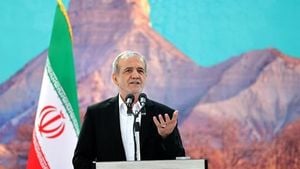The energy landscape in the United States is shifting once again, as top policymakers and industry leaders grapple with the complex realities of fossil fuel production, renewable energy, and market volatility. On June 30, 2025, Energy Secretary Chris Wright issued a directive that could set the tone for the nation’s energy strategy in the coming months: a sweeping new study, dubbed "Future Energy Systems," to be delivered by the National Petroleum Council (NPC) at its December meeting. The goal? To bolster oil and gas development while addressing the mounting strains on America’s energy infrastructure.
Wright’s letter, posted to the Department of Energy’s website, called on the NPC to "recognize and leverage the vast potential of domestic oil and natural gas resources and industry expertise to advance administration goals." The study is set to focus initially on two fronts: permitting—the often-arduous process of getting new energy projects off the ground—and "gas-electric coordination," a technical but critical challenge as electricity demand soars and natural gas pipelines groan under the pressure.
"The analysis should assess how rising power and gas demand are straining natural gas pipelines in key regions of the United States; examine what impact these strains can have on energy reliability; and recommend actionable strategies to address the misalignment between these two industries," Wright wrote to Alan Armstrong, chair of the petroleum council. The recommendations are meant to feed directly into the National Energy Dominance Council, a White House panel created by President Donald Trump and led by Interior Secretary Doug Burgum, which now coordinates and sets energy policy at the highest levels.
This latest study will also update recommendations from a 2019 NPC report, "Dynamic Delivery," produced during Trump’s first term, and will be shaped in collaboration with Deputy Assistant Secretary Ryan Peay in DOE’s fossil office. The council has 30 days from June 30 to outline the scope of the study—an ambitious timeline for a task with potentially far-reaching consequences.
But as the administration doubles down on fossil fuels, the mood in the oil patch is anything but celebratory. According to a quarterly survey released September 24, 2025, by the Federal Reserve Bank of Dallas, oil and gas executives are growing increasingly pessimistic about the market and the very policies meant to support them. Regulatory changes, trade uncertainty, and tariffs—particularly those on steel, a key material for pipelines and drilling equipment—are being blamed for falling production levels and ongoing market chaos.
One executive, quoted in the Dallas Fed survey, put it bluntly: "The uncertainty from the administration’s policies has put a damper on all investment in the oilpatch. Those who can are running for the exits." Another warned, "A vibrant oilfield services sector is critical if and when the U.S. needs to ramp up production. Right now, we are bleeding." The survey marks the third consecutive quarter in which executives have slammed the administration, which had promised to revive fossil fuel production after years of what it saw as discouragement under the Biden administration.
Ironically, some executives believe the Trump administration’s crackdown on renewable energy—intended to solidify fossil fuels’ dominance—could backfire. They warn that stymieing wind and solar development could invite harsher methane regulations, stricter permitting, or more environmental reviews, all of which would further complicate life for oil and gas producers. Others point to the administration’s continued tariffs as a key driver of rising supply chain costs, compounding the pain from dropping crude prices.
Indeed, the numbers paint a sobering picture. U.S. Energy Information Administration data shows that while gasoline prices have fallen compared to last year, electricity prices are up roughly 6 percent and natural gas prices have increased more than 9 percent compared to the same period in 2024. Executives now forecast that West Texas Intermediate (WTI) crude will hover in the low $60s per barrel through 2027—a sharp downgrade from previous expectations that prices would rebound to the $70s in the next two years. Only a small number of survey respondents believe current policies will substantially increase crude and natural gas production over the next five years; more than half expect only a slight increase, and over 30% see no change at all.
President Trump, for his part, has continued to tout his administration’s energy bona fides. Speaking at the U.N. General Assembly on September 23, 2025, he declared, "We have an expression: ‘drill, baby drill.’ And that’s what we’re doing," pointing to lower gasoline prices as evidence of success. Yet, the disconnect between Washington’s messaging and the industry’s lived experience is growing more pronounced. Some executives have gone so far as to accuse the administration of aligning with OPEC—using supply tactics to push prices below economic thresholds and "kneecapping U.S. producers in the process." One executive said, "Guided by a U.S. Department of Energy that tells them what they want to hear instead of hard facts, they operate with little understanding of shale economics. Instead of supporting domestic production, they’ve effectively aligned with OPEC—using supply tactics to push prices below economic thresholds, kneecapping U.S. producers in the process."
The National Energy Dominance Council, meanwhile, is pressing ahead with its own ambitious agenda. Brittany Kelm, a senior policy adviser on the council, outlined at National Clean Energy Week in Washington that the group is "really focused" on developing baseload power that runs around the clock, supporting the construction of data centers, and reexamining permitting changes. "It’s down to prioritizing baseload power, a directive of President Trump. … We wake up every day with no question of what our priority objectives are," Kelm explained. The council is not just focused on pipelines and fossil fuels; it’s also pushing for "anything on the nuclear side," having worked closely with the White House legislative team to retain the nuclear tax credit in the One Big Beautiful Act signed in July 2025.
Still, the sense of unease in the industry persists. Many executives worry that if current market conditions continue—marked by regulatory uncertainty, trade disputes, and depressed prices—operators will be forced to reduce workforces even further. The optimism that once surrounded Trump’s "drill, baby, drill" agenda has given way to a more sober assessment: policies alone may not be enough to turn the tide, especially when global market forces and domestic policy choices seem to be working at cross-purposes.
Environmental advocates, for their part, are sounding the alarm about the direction of U.S. energy policy. Allie Rosenbluth, U.S. Campaign Manager at Oil Change International, warned, "Trump and his fossil fuel megadonors are ensuring the U.S. stays stuck in a destructive, expensive energy system that belongs to the past." She and others fear that rolling back clean energy incentives will ultimately drive prices higher and leave the nation more vulnerable to future shocks.
As the December deadline for the NPC’s "Future Energy Systems" study approaches, all eyes will be on whether the administration’s latest efforts can bridge the gap between lofty policy ambitions and the harsh realities of the marketplace. For now, the U.S. energy sector remains caught between competing priorities, uncertain about what the future holds but keenly aware that the stakes have never been higher.




